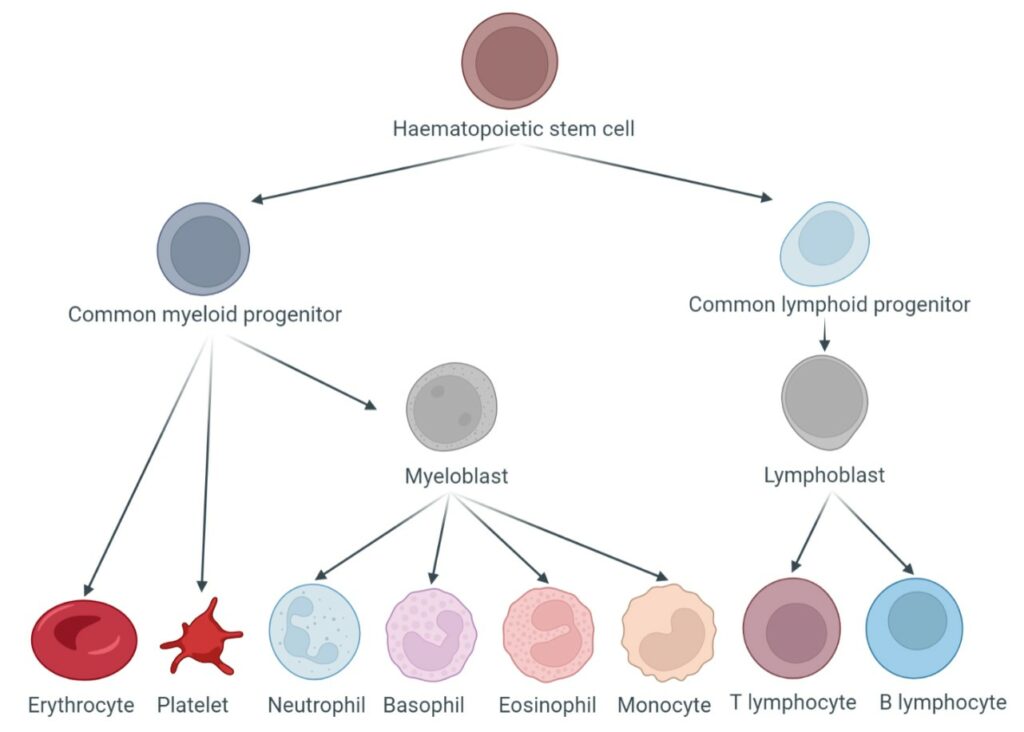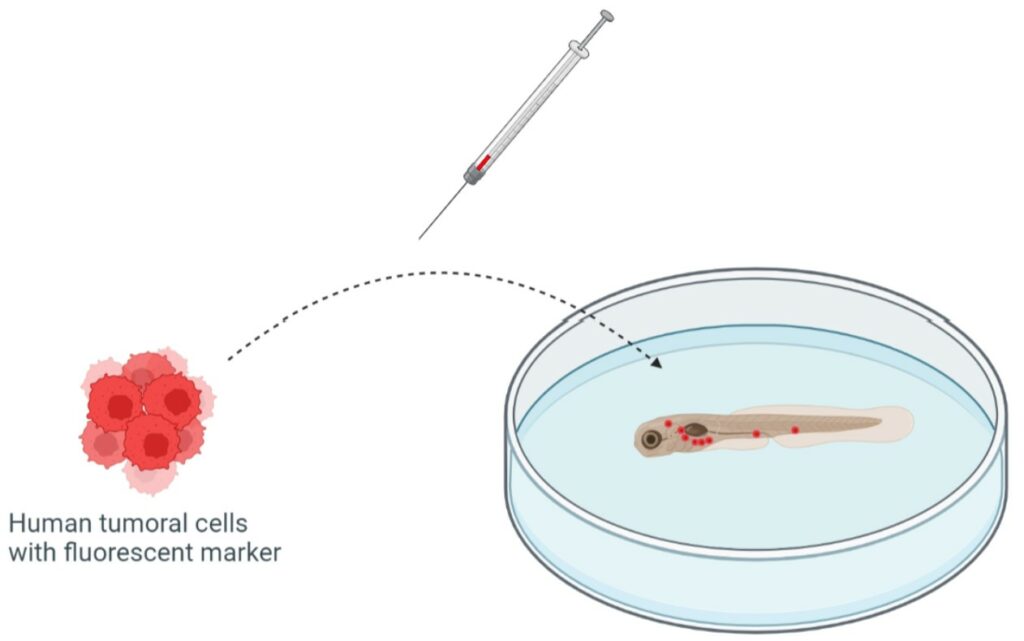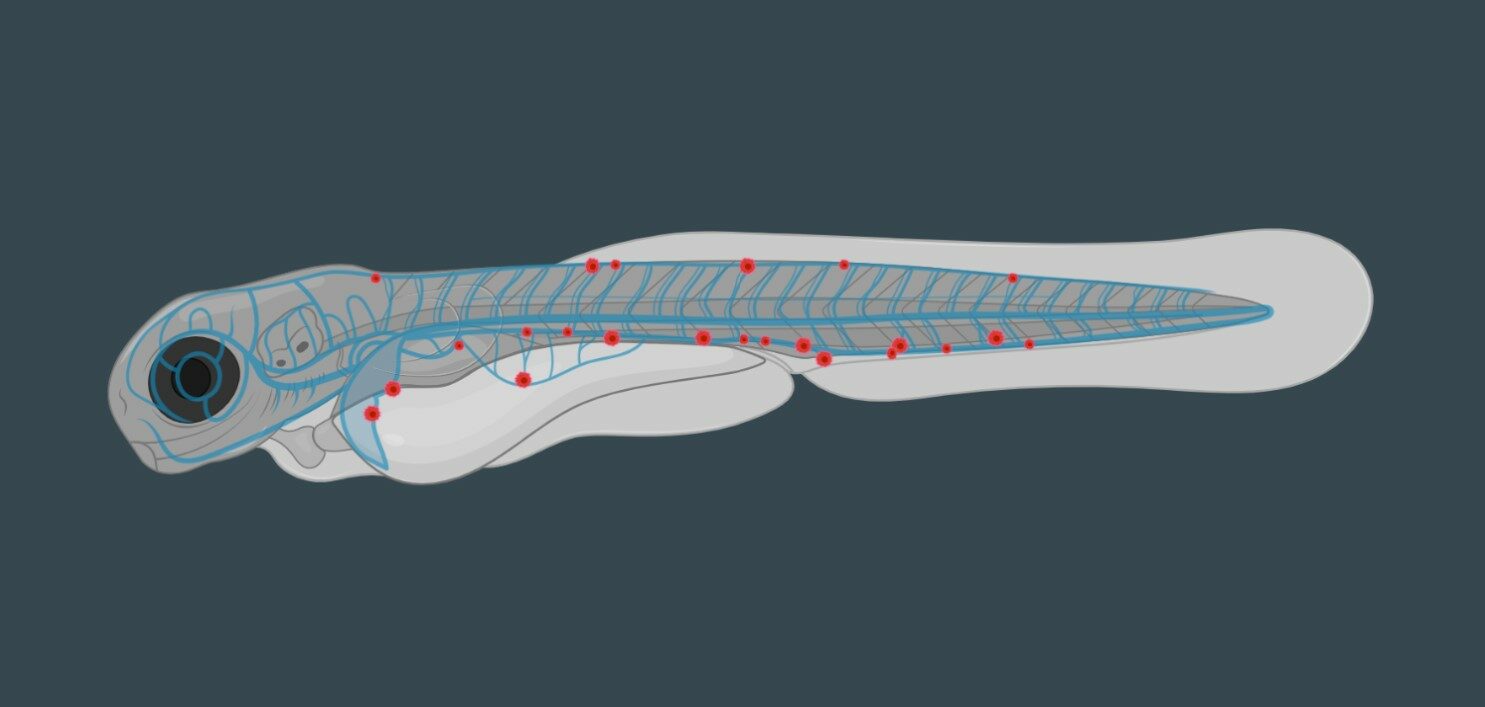September is blood cancer awareness month. Leukemia is the broad term for blood cancer, and just in Switzerland, there are more than 1000 new cases listed per year. It is also the most common childhood cancer (1). The diversity of leukemia and the ineffectiveness of current treatments call for new treatments tailored to each individual, using the patient’s own tumor cells. Zebrafish are interesting for personalized medicine due to their similarities with human genetics and physiology. In fact, about 70% of human disease genes have an equivalence in zebrafish (2).
This article presents how zebrafish may be used to treat leukemia and the way that they allow the practice of personalized medicine with xenografts.
Leukemia
Leukemia is a “cancer that starts in blood-forming tissue, such as the bone marrow, and causes large numbers of abnormal blood cells to be produced and enter the bloodstream” (3). Indeed, blood cells such as erythrocytes, lymphocytes and thrombocytes are produced in the bone marrow from a stock of hematopoietic stem cells. Leukemia can be classified in different types depending on which cells are affected and if they are slow-growing (chronic leukemia) or fast-growing (acute leukemia)(4).
Erythrocytes, also called red blood cells, are the most common blood cell type and come from common myeloid progenitors (CMP), which are derived from the stem cells. Their most important function is gas (O2 and CO2) transport. Thrombocytes is the other name for platelets and are responsible for coagulation. They also come from CMP. Lymphocytes are white blood cells and are in charge of defending the organism. T lymphocytes and B lymphocytes come from CMP and basophils, neutrophils, eosinophils, and monocytes from common lymphocyte progenitors (CLP) (5) . Leukemia affects CMP and CLP that proliferate incorrectly.

If you want to learn more about blood cells, you can find more information by clicking on the cell names below.
Neutrophils are important cells for the body’s innate immunity. During infections, they perform diapedesis; they are attracted to the site of infection and migrate to it. They perform phagocytosis (capture other cells or waste products) and act against bacteria by releasing antibacterial proteins.
Basophils are important in the mechanism of allergic reactions. Indeed, the granules they contain are filled with histamine, heparin and serotonin. Histamine is a molecule involved in the allergic response, heparin is an anticoagulant molecule and serotonin is a chemical mediator responsible to responsible for initiating the allergic reaction.
Eosinophils play a role in the fight against digestive and respiratory parasites. They are also important in allergic reactions as they have an anti-inflammatory property.
Monocytes can penetrate infectious tissues. When then are inside the tissues, they transformed themselves in macrophage or dendritic cells. Macrophages do the phagocytosis and dendritic cells are antigens presenting cells.
There are several types of T cells. They play an important role in active immunity. They are destructors of antigens (something recognised as foreign to the body). Active immunity is a type of immunity that develops throughout an individual’s life and is most effective with repeated contact.
B cells produce antibodies and are responsible to the immunity memory. They present to antigens to T cells which are responsible to destruct them.
Personalized medicine and zebrafish
Personalized medicine is based on genetic, genomic and environmental information of each patient. Domains contained in this term are: risk prediction, disease diagnosis and molecular characterization, disease prognosis, pharmacogenomics, monitoring disease response to therapy and pathogens genomes (6). It exists because if you take for example 15 patients with the same medication to treat the same kind of cancer, it is likely that each of them is going to respond very differently to the treatment. Some of the current possibilities for personalized medicine are genomic information related in databases, pharmacogenetics and pharmacogenomics (7). Databases allow access to several variations of human genomes. Pharmacogenetics is “the science that studies how genetic variations in individuals affect their response to medications” (7), while pharmacogenomics studies the way that genetic variations affect drug development (7). The advantage of these methods is mainly prevention. That is to predict the appearance of a disease before the arrival of the first symptoms. Animal models are also already in use. Patient-derived tumor xenograft (PDX) models in mice are gaining popularity (8). However, working with mammals is not particularly easy due to the high costs, the long wait for results and the legislation on the protection of animals for research. These difficulties lead researchers to look for alternative solutions, one of them being to replace mice with zebrafish.
In fact, zebrafish are increasingly used in labs because of their numerous advantages : they are easy to feed and breed, they have a short generation time, their eggs are transparent and until 120 hours post-fertilization, they are not protected by the European Union Directive on the protection of animals in research (2). Zebrafish are already used to drug testing because of their high similarities to mammals (2). Due to these similarities and advantages, zebrafish progressively help reducing the number of mammals used in research. They also are good candidates for transgenics: there are more than 5000 zebrafish mutants and transgenic strains already determined (2).

These are some of the many advantages of the zebrafish model that explain why this model is starting to be used for personalized medicine.
Patient-derived xenografts in zebrafish provide a great solution to put personalized medicine into practice. And why to use zebrafish and not another model organism, such as mice? One big advantage of using zebrafish is that this model provides a one-week assay. Speed in these cases is essential because the time of the assay must be compatible with that of a clinical decision. Moreover, thanks to the external fertilization and development of the zebrafish embryos, human tumor cells can be implanted quite early in the embryos (11).
Patient-derived xenografts and zebrafish
A xenograft is a tissue transplantation from a member of one species to a member of another species (12). Patient-derived xenografts in zebrafish are models of cancer where the tissue or cells from a patient’s tumor are implanted into a zebrafish embryo. As part of personalized medicine for leukemia, patient tumoral blood cells with fluorescent markers are transplanted to zebrafish eggs by injection. Until 48 hours post fertilization, the zebrafish immunity system is not yet established and therefore transplants are available. Graft in zebrafish after 48 hours post fertilization requires a zebrafish strain with a severe combined immunodeficiency (9,10,13).
In this way, it is possible to follow the development of the tumor or cancer cells to test different anti-tumoral drugs and to also provide a better understanding of the mechanisms of tumor-induced angiogenesis. It is also possible to monitor the development of metastases (9,10,13). Metastases are cells that detach from the primary tumor and then proliferate in a new environment (14). In vivo monitoring is then achievable at every moment for up to 7 days, thanks to the transparency of the zebrafish body. Another advantage of zebrafish is that they form their blood cells in the same way as humans and that allows the blood cell transplantation to be compatible with zebrafish (9,10,13).

As xenografts must be done in living embryos, researchers have to sort fertilized and unfertilized zebrafish eggs to select only fertilized eggs. Using an automation method like the EggSorter would save time and will allow to work more efficiently.
Conclusion
The zebrafish still shows itself as a real solution for the 3R’s principle (replace, reduce, refine) concerning experimental animals and it starts to take more and more position in personalized medicine. The monitoring of tumoral cells and the study of behavior of metastatic cells are essential to reduce mortality in cancers like leukemia. The ease of visualization of fluorescent cells thanks to zebrafish embryo’s transparent body, the advantages of the aqueous living environment and the rapid development of the zebrafish embryo make it a good model for oncology research.
This is why zebrafish seem an appropriate model for in vivo evaluation of leukemia invasiveness, metastasis behavior, angiogenesis and response to anti-tumor therapy.
References
- Les leucémies. https://www.liguecancer.ch/a-propos-du-cancer/les-differents-types-de-cancer/les-leucemies
- Strähle U, Scholz S, Geisler R, Greiner P, Hollert H, Rastegar S, et al. Zebrafish embryos as an alternative to animal experiments—A commentary on the definition of the onset of protected life stages in animal welfare regulations. Reprod Toxicol. 1 avr 2012;33(2):128‑32.
- Definition of leukemia – NCI Dictionary of Cancer Terms – NCI. 2011
- Blood Cancer UK | Leukaemia. Blood Cancer UK. https://bloodcancer.org.uk/understanding-blood-cancer/leukaemia/
- Dzierzak E, Philipsen S. Erythropoiesis: Development and Differentiation. Cold Spring Harb Perspect Med. avr 2013;3(4):a011601.
- Chan IS, Ginsburg GS. Personalized Medicine: Progress and Promise. Annu Rev Genomics Hum Genet. 2011;12(1):217‑44.
- Vogenberg FR, Isaacson Barash C, Pursel M. Personalized Medicine.Pharma Ther. oct 2010;35(10):560-76
- National Academies of Sciences E, Studies D on E and L, Research I for LA, Use R on S and W in LA. Introduction to Precision Medicine and Animal Models. Advancing Disease Modeling in Animal-Based Research in Support of Precision Medicine: Proceedings of a Workshop. National Academies Press (US); 2018.
- Chen X, Li Y, Yao T, Jia R. Benefits of Zebrafish Xenograft Models in Cancer Research. Front Cell Dev Biol. 2021;9.
- Konantz M, Balci TB, Hartwig UF, Dellaire G, André MC, Berman JN, et al. Zebrafish xenografts as a tool for in vivo studies on human cancer. Ann N Y Acad Sci. 2012;1266(1):124‑37.
- Costa B, Estrada MF, Mendes RV, Fior R. Zebrafish Avatars towards Personalized Medicine—A Comparative Review between Avatar Models. Cells. 2020; 9(2):293
- Definition of xenograft | Dictionary.com
- Somasagara RR, Huang X, Xu C, Haider J, Serody JS, Armistead PM, et al. Targeted therapy of human leukemia xenografts in immunodeficient zebrafish. Sci Rep. 11 mars 2021;11(1):5715.
- Raby L, Völkel P, Le Bourhis X, Angrand PO. La transplantation de cellules tumorales chez le poisson zèbre : de la recherche translationnelle à la médecine personnalisée. Bulletin du Cancer. Volume 107, Issue 1, 2020, Pages 30-40
All images have been created with BioRender.com.




